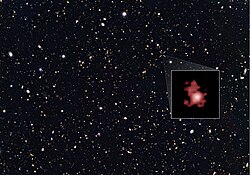This article needs additional citations for verification .(December 2016) |
| Discovery | |
|---|---|
| Discovery date | June 2016 |
| Transit | |
| Orbital characteristics | |
| 0.1283 au | |
| 15.57208±0.00002 [1] d | |
| Inclination | 88.75±0.13 [2] [1] |
| Star | HIP 41378 [1] |
| Physical characteristics | |
| 2.595±0.036 R🜨 | |
| Mass | 6.89±0.88 ME |
HIP 41378 b (also known as EPIC 211311380 b) is an exoplanet orbiting around the F-type star HIP 41378. It has a radius about 2.6 times that of Earth.


